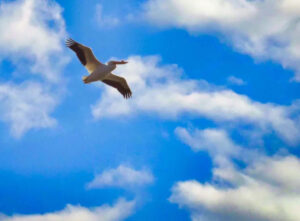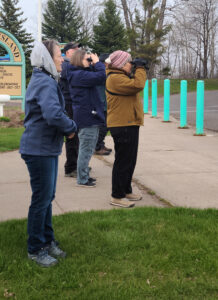Using Sound to Connect People to Green Bay
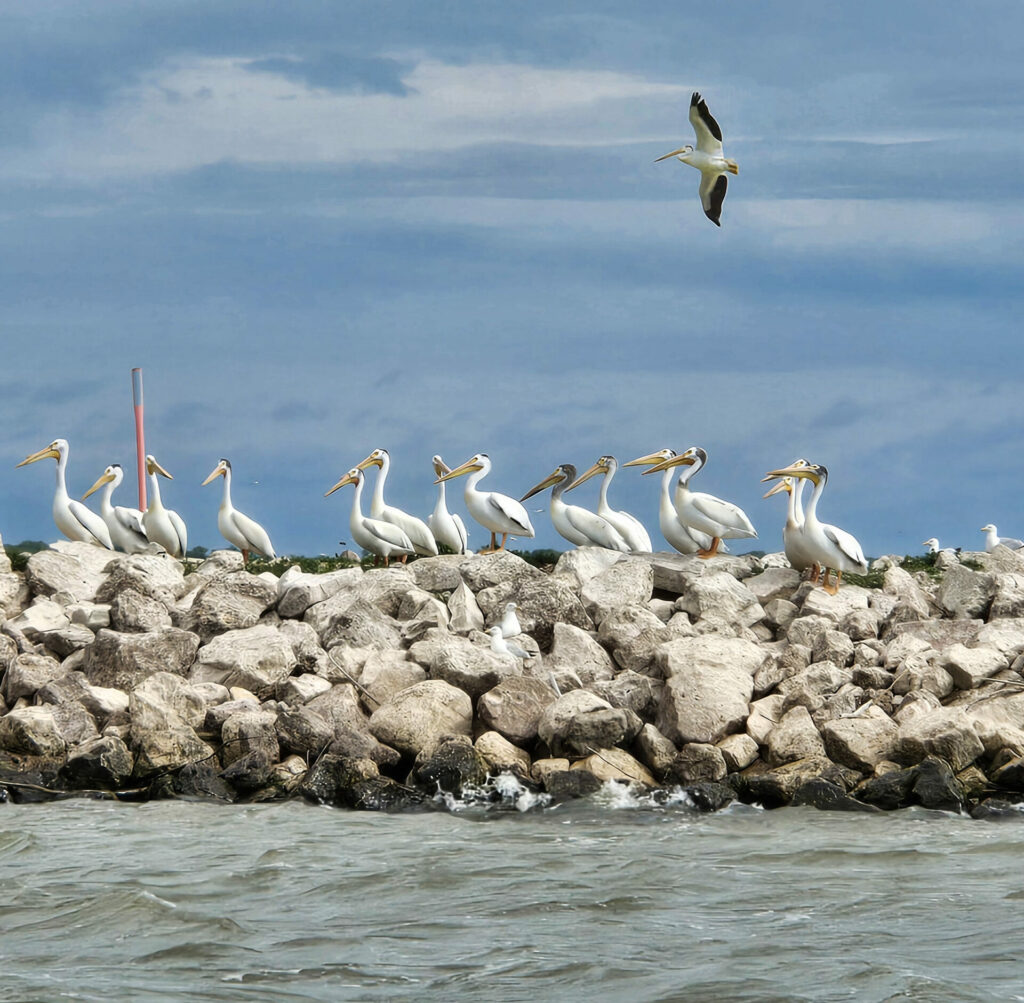
American white pelicans at their nesting colony on Cat Island in Green Bay. Image credit: Marie Zhuikov, Wisconsin Sea Grant
On a sunny morning in mid-June, the University of Wisconsin-Green Bay’s research vessel, Phoenix, headed out onto the bay. Aboard were Sea Grant researchers Emily Tyner and Bill Sallak and a small mound of recording equipment. The boat was piloted by Chris Houghton, assistant professor and fish ecologist, who was assisted by first mate, undergraduate student Jacob Hoffman.
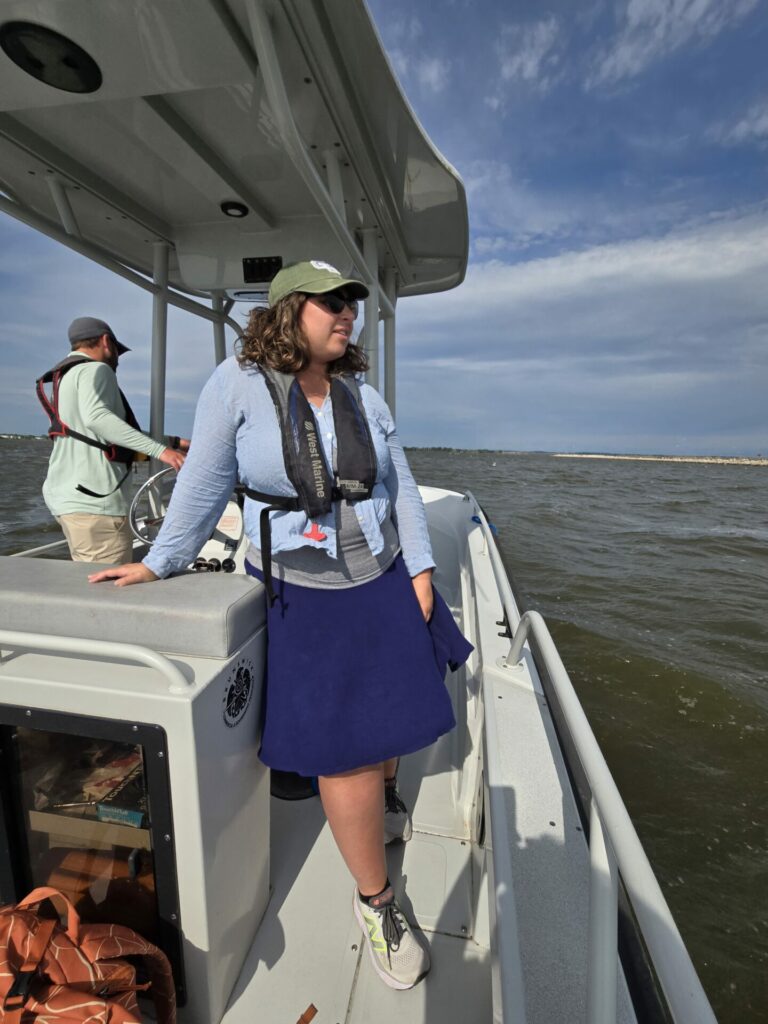
Emily Tyner aboard the Phoenix, UW-Green Bay’s research boat. Image credit: Marie Zhuikov, Wisconsin Sea Grant
The bay outing’s purpose was to collect the natural noises of the estuary, particularly bird sounds. It was only supposed to last for three hours but like in the theme song for the “Gilligan’s Island” television show, a mishap was involved.
Tyner and Sallak’s project is associated with the development of a national estuarine research reserve on the bay. The National Estuarine Research Reserve System is a network of 30 coastal sites that protect and study estuaries. In the Great Lakes, estuaries are areas where rivers empty into the lakes. The mission of the reserves is to practice and promote estuary stewardship via innovative research and education projects through a system of protected areas. It’s a partnership program between the National Oceanic and Atmospheric Administration and coastal states.
Tyner, director of freshwater strategy at UW-Green Bay, is the state lead on the designation of a new National Estuarine Research Reserve for the Bay of Green Bay. It will be the third reserve on the Great Lakes after Old Woman Creek in Ohio on Lake Erie and the Lake Superior Reserve in Superior, Wisconsin. Sallak is an associate professor of music and was sound recorder for the trip.
Their target was the Cat Island Chain, restored barrier islands in the bay that have created new habitat for migrating and nesting shorebirds. Then, if time allowed, they would visit several other sites.
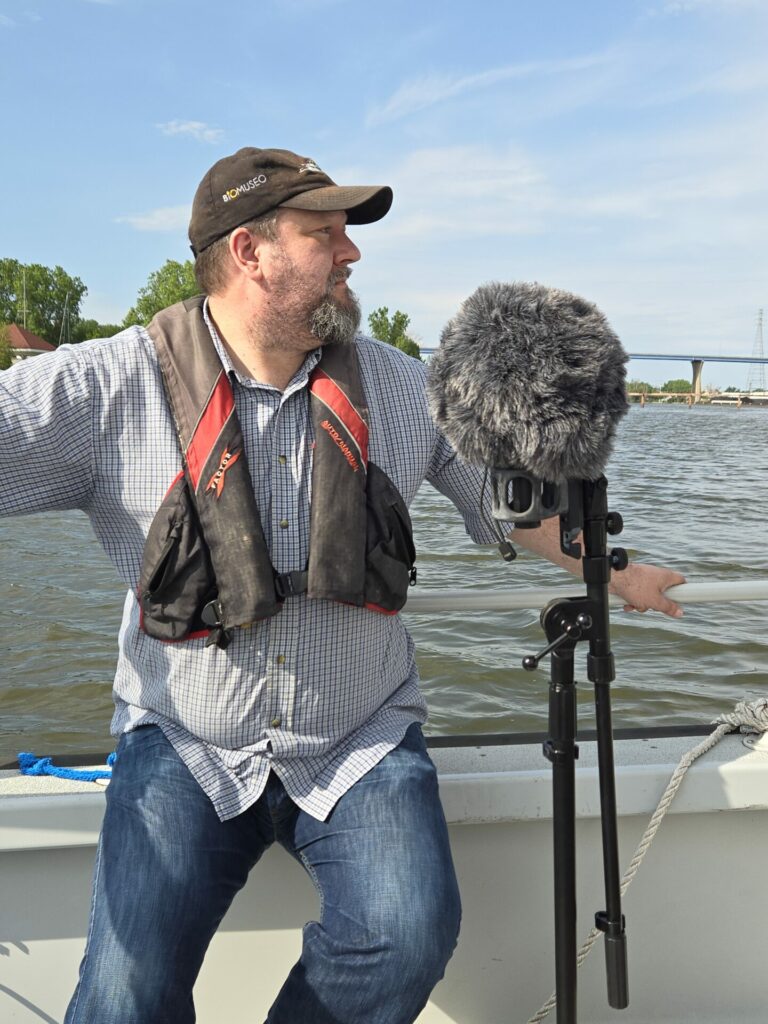
Bill Sallak with sound recording equipment. Image credit: Marie Zhuikov, Wisconsin Sea Grant
Sallak described how the idea for this project evolved. “Part of our original conception was more of a hard science, bioacoustics angle. But then, we went out on a boat trip and we went, ‘That sounds cool, that sounds cool. All these things sound really fantastic.’ And so, we decided to lean more towards a more humanistic angle, which is also going to work better if we get to the point where there’s a visitor’s center, because we can take these recordings and put them into a room with a surround sound speaker set up, and you can hear the bay in different locations, different seasons.”
In their proposal, Tyner and Sallak stressed the importance of bringing the sounds of the Green Bay estuary to the community. Tyner elaborated, “Right there is a restaurant that’s one of the only places on the lower bay where you can go and have a beer and have a burger and be sitting out on the water. And there’s almost no other places to kind of enjoy the bay. There’s the amusement park, but then there’s no pier or boardwalk for access. There’s no swimmable beaches. Some of that’s for water quality reasons. To get onto the bay, you need to have a boat, an expensive boat, probably. Maybe you can do a bit of kayaking from shore, but a trail system, we don’t really have that.
“For a long time, communities had closed themselves off from around the bay because of smells and harmful algal blooms and industrial uses. But now Green Bay and other communities are reopening and turning their front doors back. Especially with the Fox River cleanup, which was a $1.5 billion effort. And so, with that kind of trying to encourage the city and communities to turn their front doors this way, we also want to reconnect people. This is one step in getting us there,” Tyner said.
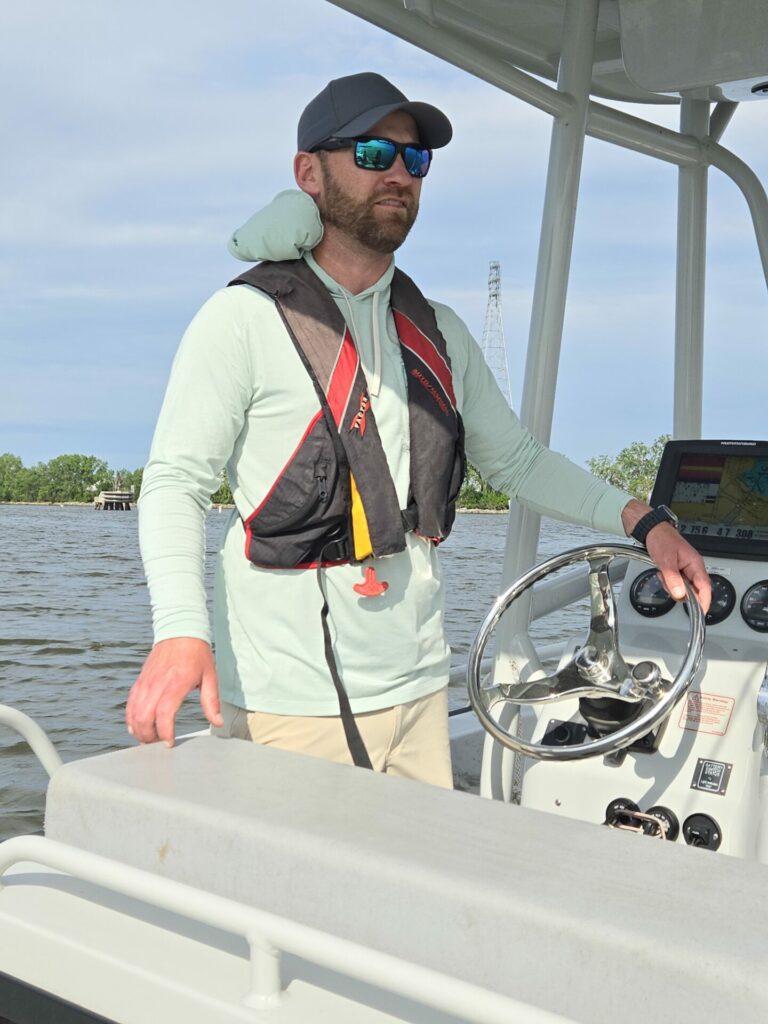
Chris Houghton. Image credit: Marie Zhukov, Wisconsin Sea Grant
In sort of a happy accident, UW-Green Bay recently received funding for a new sound auditorium. Plans are for it to be completed this fall, and this Green Bay audio project will be the first to be featured.
Sallak explained. “Now the audio production program at the Resch Institute for Music is going to have probably the best facilities in higher education in the state. We were able to find about 1,600 square feet in the studio arts building and some underused space in the Wiedner Center. We’re putting in four new recording studios, one of which is an Atmos room. So, it’s equipped with a 14-speaker surround sound setup.”
He said it will be the same surround sound audio system that’s used in movie theaters. They’ll have the capacity to make surround sound recordings and present them in an acoustically refined space. When the Atmos room is finished, the Green Bay sounds project will be the first presentation featured in it. The sound files will also be available on a webpage.
The first of five stops on the boat tour was off the gull colony at Cat Island. Amid raucous gull calls, Sallak set up the recording equipment on the boat. He tagged the sound file with the date, time and location. After capturing several minutes of sound, he turned off the equipment as the Phoenix made its way to the pelican colony at the other end of Cat Island. The pelicans were very quiet, so there wasn’t much to record, but dozens of the prehistoric birds flying overhead made for some inspiring photos.
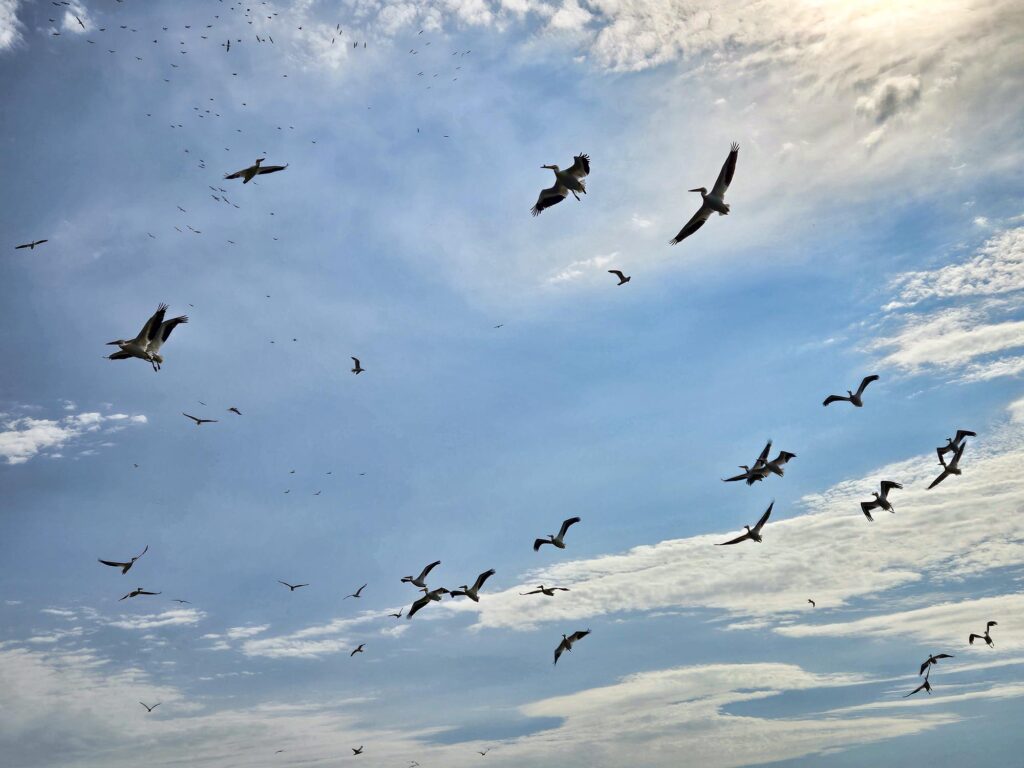
Pelicans wheel in the sky over Cat Island. Image credit: Marie Zhukov, Wisconsin Sea Grant
Their third stop was Longtail Point Lighthouse, a crumbling structure on a long sandy point. After Sallak recorded the sounds for several minutes, the unexpected happened.
“We’re beached,” Houghton said as the bottom of the boat came to rest on the sandy bottom.
“Uh oh,” Tyner said.
“Shouldn’t be a problem.” Houghton laughed, “Famous last words.”
Sallak chimed in, “We’re not going to run out of granola bars? Figure out who we have to eat first?”
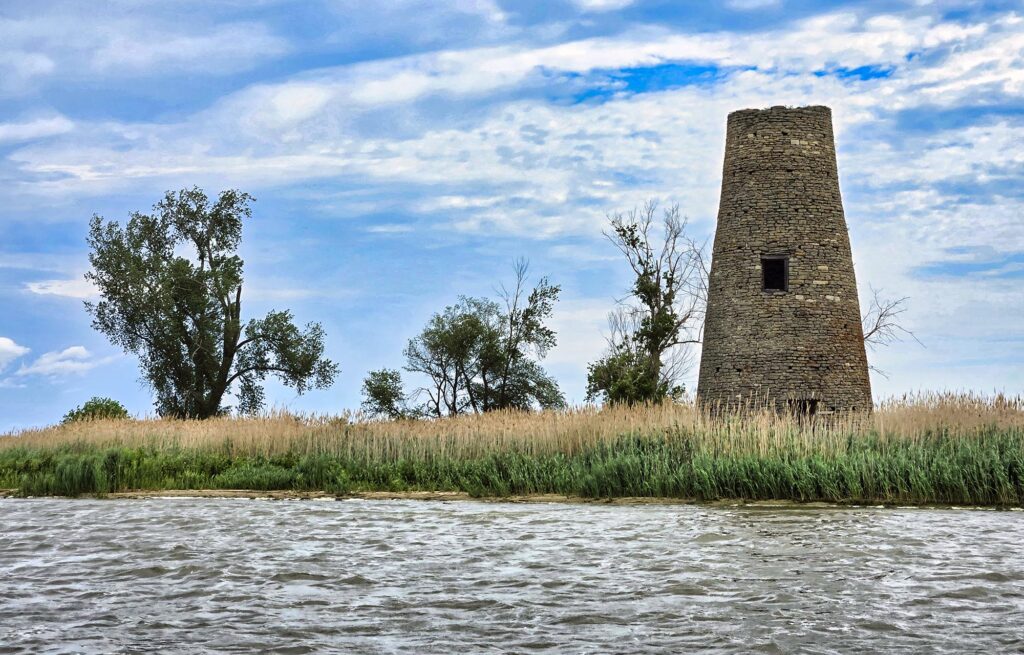
Long Tail Point Lighthouse. Image credit: Marie Zhukov, Wisconsin Sea Grant
Houghton and Hoffman jumped over the side of the boat and tried to free it from the bottom. After some finagling, they were able to push it into deeper water.
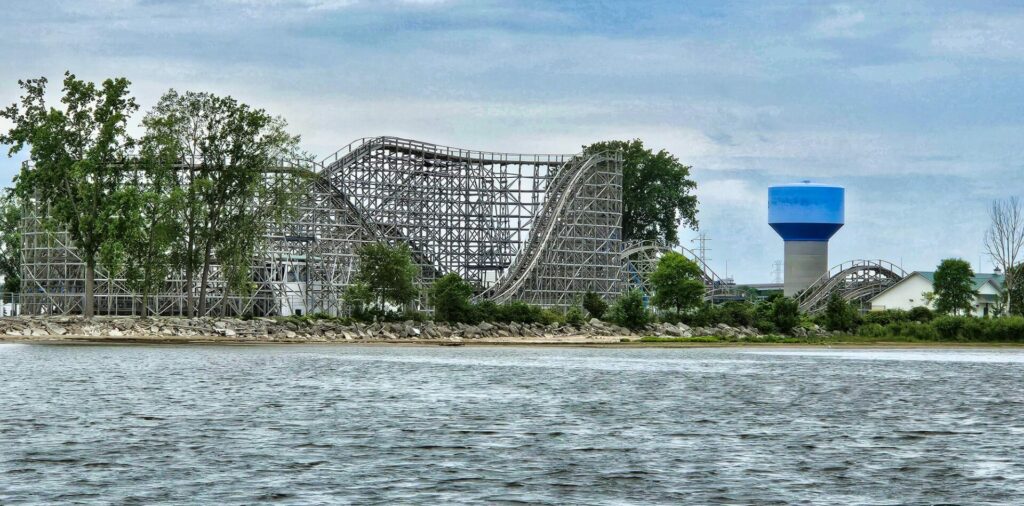
The Zippin Pippin rollercoaster, Bay Beach Amusement Park. Image credit: Marie Zhukov, Wisconsin Sea Grant
Audio captured, the team moved onto the next stop, which had the ominous name of Dead Horse Bay. As they recorded, a bald eagle sat in a tree, watching as songbirds chirped and twittered. A plane flew overhead, and someone fired up a chain saw on shore. Sallak said he would keep those human sounds in the show. “We’re not apart from everything that’s going on. I’m more interested in collecting what’s literally here than trying to erase.”
Their fifth and final stop was full of human sounds offshore of Bay Beach Amusement Park. One of the most noticeable features there is the Zippin Pippin — a rollercoaster. The team watched as the coaster cars made their slow way up to the top of the ride and then plummeted, eliciting screams from the riders. Sallak said he has plans to go into the courtyard in the middle of the ride and get a recording for this project later.
With audio captured, the team motored back to the marina. They agreed there’s nothing like spending a morning on the water, even if it involved getting beached.
To hear a podcast episode of this story, complete with sounds, visit this Wisconsin Water News page.
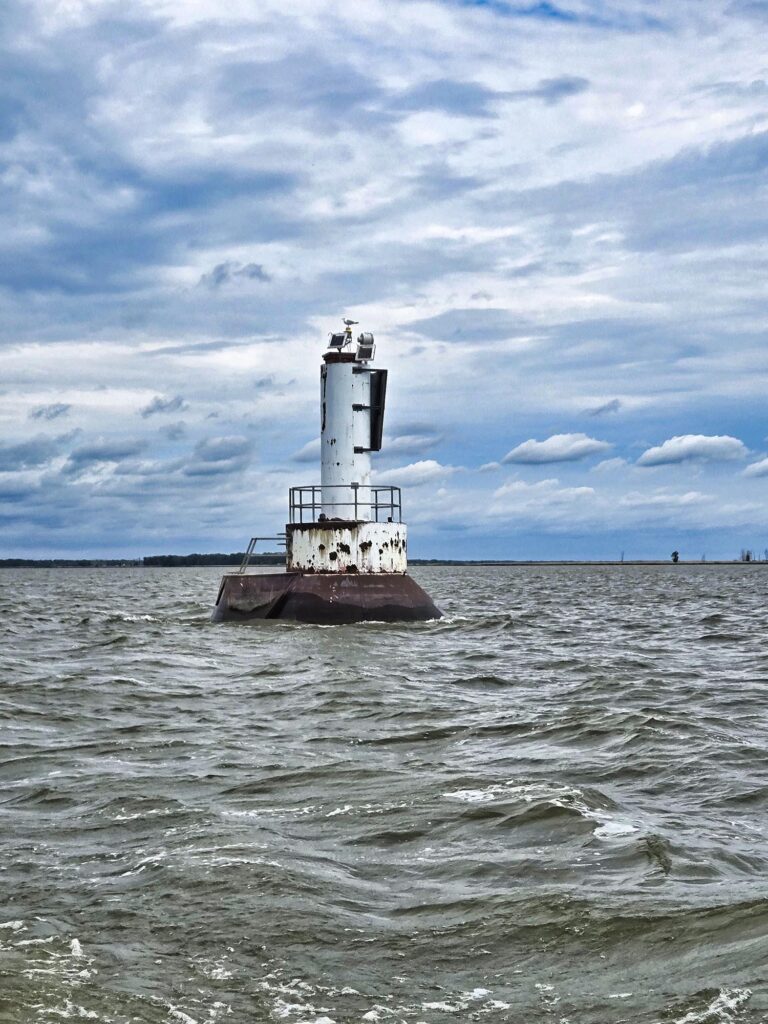
A navigation beacon in Green Bay. Image credit: Marie Zhuikov, Wisconsin Sea Grant
The post Using Sound to Connect People to Green Bay first appeared on Wisconsin Sea Grant.
News Releases | Wisconsin Sea Grant
News Releases | Wisconsin Sea Grant
https://www.seagrant.wisc.edu/news/using-sound-to-connect-people-to-green-bay/


